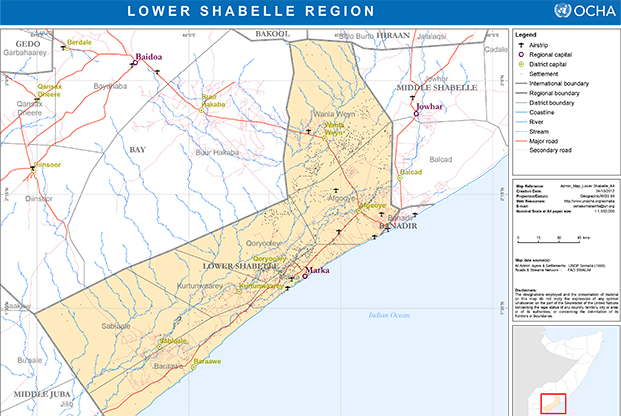
This map, created by the United Nations Office for the Coordination of Humanitarian Affairs, depicts the Lower Shabelle Region of Somalia. UNOCHA graphic.
US Africa Command on Tuesday pushed back against allegations of civilian casualties from US strikes in Somalia, claiming that in more than 100 strikes in that country since 2017, not a single civilian has been killed.
However, also Tuesday, Amnesty International released an in-depth report alleging 14 civilians were killed and eight injured in five US strikes targeting al Shabaab between 2017 and 2018. Defense officials speaking on background with reporters confirmed the US did conduct the strikes Amnesty investigated, but said, “We differ with their assessment” that civilians were killed.
In research for the report, Amnesty submitted allegations of civilian casualties to AFRICOM, which used surveillance footage, signals intelligence, and a review of open source and social media reporting of the incident to analyze the allegations.
“We use every available source and method to create an understanding of the circumstances,” a DOD official said.
However, AFRICOM said it did not conduct on-the-ground battle damage assessments, largely because of the risk of putting additional people in danger in al Shabaab territory and because the command is largely confident in its assessment of what happened.
“Amnesty’s conclusions are incorrect,” the official said.
The Amnesty report focused specifically on operations in the southernmost Lower Shabelle region of Somalia. The organization used first-hand testimony from witnesses and survivors of strikes, along with satellite imagery, photographs, and interviews with medical personnel, among other methods.
It alleges that:
- On Oct. 16, 2017, a remotely piloted aircraft targeted an al Shabaab vehicle between Awdheegle and Bariire, killing two civilians and injuring another five who were residing near the road.
- On Nov. 12, 2017, an airstrike on farms near the village of Darusalaam killed three civilian men who were sleeping under a tree. Photographs of the scene show a GBU-69B Small Glide Munition was used in the strike, reportedly from an AC-130.
- On Dec. 6, 2017, an airstrike on a vehicle carrying al Shabaab fighters near Illimey also killed five civilians, including two children. Up to 10 structures were partially or completely destroyed in this strike. The report does not say what aircraft, service, or country specifically conducted this strike, but says it was “most plausibly” caused by the US.
- On Aug. 2, 2018, a US drone strike killed a suspected al Shabaab member and three civilians who were driving near the village of Gobanle.
- On Dec. 9, 2018, an airstrike near the village of Baladul-Rahma killed a civilian farmer. In this instance, AFRICOM said it did conduct a strike in the region, but did not provide details of casualties.
“The civilian death toll we’ve uncovered in just a handful of strikes suggests the shroud of secrecy surrounding the US role in Somalia’s war is actually a smokescreen for impunity,” said Brian Castner, Amnesty International’s senior crisis adviser on arms and military operations, in a release. “Our findings directly contradict the US military’s mantra of zero civilian casualties in Somalia. That claim seems all the more fanciful when you consider the USA has tripled its air strikes across the country since 2016, outstripping their strikes in Libya and Yemen combined.”
AFRICOM said Tuesday that allegations of civilian casualties can benefit al Shabaab by raising public distrust in Somali, African Union Mission in Somalia, and of US forces in the region. Al Shabaab has made claims of civilian casualties using old or doctored footage in its own media outlets, and has coerced some local civilians to make incorrect claims of casualties.
AFRICOM has steadily increased the amount of strikes it is conducting in Somalia, from 35 in 2017, to 47 in 2018, and 28 so far in 2019, including a strike on Tuesday that reportedly killed three al Shabaab militants near the town of Awdheegle.
Since June 2017, AFRICOM assesses it has killed about 800 al Shabaab fighters.
AFRICOM officials said Tuesday the number of strikes have increased as local partners have become more capable on the battlefield and increased their pace of operations. For example, Somali forces have improved their ability to gather information following a raid and in turn use that to develop more targets. AFRICOM, however, would not say if these forces are specifically providing targeting locations directly to US forces.
The increasing pace of strikes has meant that more “al Shabaab formations are [being] taken off the battlefield,” and they are losing their ability to recruit, train, and amass forces, an AFRICOM official said.
“The bottom line, we’re taking formations, fighters, leaders off the battlefield, and that’s having an effect on the network,” the official said.
The US military currently has between 500-600 forces on the ground in Somalia, which are deployed to multiple partner locations throughout the country. Airstrikes have largely come from remotely piloted aircraft, though the Amnesty report includes an AC-130 mission, and other strike aircraft that have deployed to Camp Lemonnier in nearby Djibouti. In addition to US aircraft, other nations such as Kenya and Ethiopia have conducted airstrikes in Somalia.